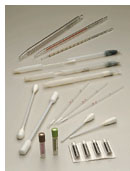Volume 6 |
|
 |
|||
| TEEL's Multi-Layered Tubing May Solve Your Application Needs | |||
If you are experiencing a difficult application problem, TEEL's Custom Multi-Layered Tubing could be the answer you need. For example, are you looking for tubing that has a barrier protection to blood, human tissues or gases? Does your application require tubing that resists chemicals? Do you need tubing that is durable enough to be used as a fuel line? These are just a few of the difficult application problems TEEL's Custom Multi-Layered Tubing is able to solve. With our Multi-Layered Tubing (MLT) technology, we can combine up to five layers into a composite wall. By doing this, we are able to achieve properties that a single material does not have on its own. The material combinations are dependent upon the properties you want to achieve. Currently, we offer customers two-, three-, four- or five-layered tubing in outside diameter ranges from 0.100" to 4.000". Multi-layered tubing can save money when it displaces a more expensive material. For instance, material costs can be lowered if an expensive material is reduced to a layer of minimal thickness and the balance of the tube wall consists of a lower cost material. (However, it's important to keep in mind that there is normally a production cost premium for MLT, which obviously affects the net cost reduction.) Fluoropolymer-lined polyethylene tubing is a good example of this cost-saving approach. Polyethylene, by itself, does not have the chemical resistance required for certain applications. On the other hand, fluoropolymers often have the resistance needed but can be costly. Combining the two materials--using a thin layer of the more expensive fluoropolymer on the critical inside surface while relying on the polyethylene to provide the bulk properties of the tube--yields an intermediately priced alternative with acceptable properties. Multi-Layered Tubing is also a good choice for many piping applications. Typical off-the-shelf pipes may be over-engineered for certain noncritical, low pressure applications. Displacing the core thickness of the pipe wall with foamed material, while maintaining the integrity of the surface with unfoamed skins, is another potential way to reduce cost. |
Other applications for MLT can be found in the medical industry. In some medical operations, tubing is
inserted into the body. This tubing  must be visible using X-rays. Barium sulfate is a commonly used filler for X-ray detection.
Because of the added cost of the filler, it is advantageous to reduce the filled material to a thin layer in the multi-layered tube's wall. must be visible using X-rays. Barium sulfate is a commonly used filler for X-ray detection.
Because of the added cost of the filler, it is advantageous to reduce the filled material to a thin layer in the multi-layered tube's wall.
Barrier materials, which keep vapors and gases from penetrating through the tubing wall, can be added for permeation resistance. These barrier materials can serve as a layer in the wall of your multi-layered tube. This means the performance of materials such as polyethylene and nylon can be improved to meet demands associated with emission regulations or shelf-life constraints. Automotive gas lines have historically been made of nylon 12. Recent environmental concerns and EPA regulations have necessitated the reduction of emissions from these lines. The inclusion of barrier layers such as PVDF, PBT and EVOH has enabled the continued use of plastic gas lines, which weigh less and are easier to handle than metal alternatives. Thin layers of electrically conductive materials (usually a carbon-black filler) can also be included in the structures to eliminate static buildup due to fuel flow. Food packaging tubes can be restructured with barrier materials to increase the protection of the packaged items. Typical packaging materials such as polyethylene, polypropylene and polystyrene can be improved by adding a barrier material such as EVOH to inhibit oxygen and other gases from entering (or in some cases, exiting) the package. TEEL has manufactured Custom Multi-Layered Tubing for a number of different industries, some of which include: automotive, cosmetic, medical/diagnostic, textiles, beverage, and consumer and chemical packaging. If you have a difficult tubing application and would like to discuss your requirements, please contact our sales staff at (800) 322-TEEL (8335).
|
||
| | Home | Profile | Capabilities | Newsletter | Write Us | | |||
| ©1998 TEEL PLASTICS, INC. | |||
